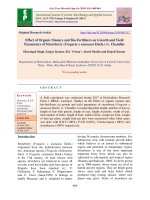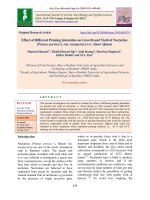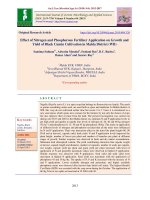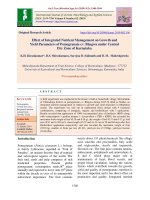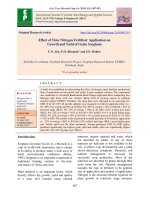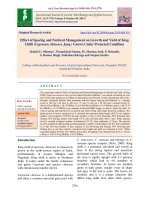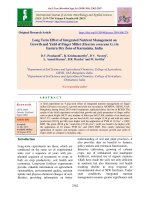Effect of mode of micronutrients application on growth and yield of pigeon pea (Cajanus cajan L.) in sandy loam soil
Bạn đang xem bản rút gọn của tài liệu. Xem và tải ngay bản đầy đủ của tài liệu tại đây (198.78 KB, 8 trang )
Int.J.Curr.Microbiol.App.Sci (2020) 9(3): 17-24
International Journal of Current Microbiology and Applied Sciences
ISSN: 2319-7706 Volume 9 Number 3 (2020)
Journal homepage:
Original Research Article
/>
Effect of Mode of Micronutrients Application on Growth and Yield of
Pigeon Pea (Cajanus cajan L.) in Sandy Loam Soil
Archana Verma*, Uday Pratap Shahi, Pankaj Chaurasia and LaxmanKumawat
1
Department of Soil Science and Agricultural Chemistry,
SVPUA&T, Meerut, Pin: 250110, India
2
Department of Soil Science and Agricultural Chemistry at Bihar Agricultural University,
Sabour, Bihar, Pin: 813210, India
*Corresponding author
ABSTRACT
Keywords
Pigeon pea,
Micronutrients,
Borax, Foliar spray,
Yield attributing
traits
Article Info
Accepted:
05 February 2020
Available Online:
10 March 2020
A field experiment was conducted during Kharif season 2018 to evaluate
the effect of mode of micronutrients application on growth and yield of
pigeon pea (Cajanus cajan L.) in sandy loam soil. Nine treatments
consisting of micronutrients (Zn, Fe and B) viz. T1 [Control (NPK)], T2
(ZnSO4 @ 25 kg/h), T3 (Fe SO4 @ 40 kg/ha), T4 (Borax@ 10 kg/ha), T5
(ZnSO4+ FeSO4+ Borax), T6 (foliar spray ZnSO4 @ 0.5%), T7 (foliar spray
FeSO4 @1%), T8 (foliar spray Borax @ 0.2%), T9 (foliar spray ZnSO4+
FeSO4+ Borax) were tested in RBD with three replications. NPK was
commonly applied in all the plots. The experimental results revealed that
growth attributes (plant height, number of primary branches), yield
attributing traits (pods plant-1, grains pod-1, test weight, dry matter
accumulation), yields viz., grain, straw and biological in pigeon pea differ
significantly among different treatments and were maximum with the foliar
spray of ZnSO4+ FeSO4+ Borax followed by soil application of ZnSO4+
FeSO4+ Borax.
guandula
(Puerto
Rico),
poisd’angola
(French), arvega de angola (Spanish),
piselloD’angola (Italian) and taubenerbse
(German) (El- Seifi et al., 2013). Arhar is
cultivated for various uses such as food crop
(dried, flour or green vegetable), forage/cover
crop, fuel wood (stalks). Pigeon pea had
Introduction
Pigeon pea (Cajanus cajan L. millsp.) belongs
to family Fabaceae or Leguminoceae. It has
many names in India such as red gram, arhar,
tur etc. In various parts of world it is known
by many names such as arhar dal (India),
17
Int.J.Curr.Microbiol.App.Sci (2020) 9(3): 17-24
originated in South Asia and it is now growing
in tropical and sub-tropical regions also. It is
grown throughout the tropical and sub-tropical
regions of the world, between 300 N and 350 S
latitudes. However, major area under pigeon
pea in India is lying between 140 S and 280 N
latitudes. After chickpea, pigeon pea is the
second most important pulse crop in India,
grown in an area of 56.02 lakh hectare with
32.90 lakh tones production (Annual Report
2016-17, GOI). This is one of the most
popular pulse crops here which is being grown
in almost all parts of country. Maharashtra (7
lac tonnes) ranks first among all states in its
area and production followed by Uttar Pradesh
(5 lac tonnes), Madhya Pradesh (3 lac tonnes),
Karnataka (3 lac tonnes) and Gujarat (1 lac
tonnes) (Anonymous, 2017). Many agronomic
practices for pigeon pea production should be
standardized for getting ultimate yield
potential, among them are soil application of
micronutrients and foliar spray of nutrients are
most important ones. It is to be noted that in
our country, the productivity of pigeon pea is
quite low due to number of factors i.e.
agronomic,
genetic,
pathogenic
and
entomological as well as their interaction with
environment. Although India stands first in
area and production of this crop, still there is
need to import this pulse crop from other
countries, it is mainly due to the higher
domestic consumption demands in our
country. In pulses, the limited nitrogen
fixation by legume- rhizobium symbiosis is
the result of mineral nutrient deficiencies.
There is deficiency of both macronutrients as
well as micronutrients (Zn, Fe, B, Mo etc.)
take place which inhibits or limits the legume
production (Bhuiyan et al., 1999). Although
micronutrients are required in limited amount
for crop growth and development but they are
as useful and important as macronutrients.
They take part in redox reactions, serves as
co-factor for enzyme activity and some other
vital functions in plants. The low yield of
pigeon pea is mainly attributed to their
cultivation on poor soils with inadequate and
imbalanced macronutrients as well as
micronutrients like zinc, iron and boron
application.
Materials and Methods
In order to further study the “Effect of Mode
of Micronutrients Application on Growth and
Yield of Pigeon pea (Cajanus cajan) in Sandy
Loam Soil” a field experiment was carried out
during the kharif season 2018 at Crop
Research Centre of Sardar Vallabhbhai Patel
of Agriculture and Technology, Meerut (U.P)
which is situated at 29081 NE latitude and
770401E longitude at an altitude of 237 m
above the mean sea level and comes in semiarid and sub-tropical climatic zone. UPAS-120
variety of pigeon pea crop was grown in
randomized plot design in three replications
with 9 treatments. The plot area was 12.6 m2
with 60 cm x 25 cm spacing. Growth
observations were recorded at 35, 75 DAS and
at harvest days after sowing of the crop. Yield
attributes were recorded at harvest.
The height was measured with the help of
meter scale from the base of plant to the tip of
the tallest leaf. Average plant height was
computed and expressed in cm. Plant height,
total numbers of branches and dry matter
accumulation were recorded at 35, 75 DAS
and at harvest from three tagged plants and
mean branches plant -1 was counted. Three
plants from each plot were randomly uprooted
from the side rows along with a soil block of
about 25 cm diameters at pre-flowering stage
(75 DAS). Adhered soil was washed off from
the roots by washing with tap water by
keeping the roots of the plants in sieve to
return the detached nodules, if any nodules
were removed from the roots carefully and
counted. The mean value of three plants was
expressed as the number of nodules plant-1. To
calculate dry matter accumulation (in grams),
three plants were taken from each plot.
18
Int.J.Curr.Microbiol.App.Sci (2020) 9(3): 17-24
Sample plants were cut close to ground level
and sample were kept in dryer for 48 hours at
720C. Therefore, dry weight of samples was
recorded with the help of electronic balance.
with the advancement in crop growth. Initially
plant height could not affected by treatments
but at later stage viz. pre-flowering and at
harvest it was significantly varied by
application of micronutrients in different
mode and combinations. Significantly lower
plant height at final stage in the control plot as
compared to rest of the treatments clearly
indicates the importance of micronutrients in
plant growth. Plant height measured at
vegetative, pre-flowering and at harvesting
stage was significantly affected by different
micronutrients application. Initially, there was
no significant variation in the plant height but
as the crop proceeds to its maturity, there was
a significant effect of micronutrients on plant
height. The plot treated with the foliar
application of ZnSO4+ FeSO4+ Borax,
produced tallest plant with highest number of
primary branches and thereby dry matter
accumulation per plant. Plant height with the
foliar application of ZnSO4+ FeSO4+ Borax
(T9) was significantly higher than the other
treatments except T5 where same were applied
in soil. Similar results in respect to plant
height have also been reported by
Handiganoor et al., (2017) and Shah et al.,
(2016).
The observation on yield and yield attributing
characteristics were recorded using standard
methods as total pods on the three tagged
plants were counted and averaged to get
number of pods plant-1. Randomly selected 10
pods from the three tagged plants of each plot
and threshed and the total numbers of grains
obtained were counted and the average
number of grains pod-1 was computed. A
representative sample of 1000 air dried grains
irrespective of shape and size was taken from
the net plot produce and their weight was
recorded on electrical digital balance. Pods
obtained from three tagged sample plants were
threshed and the grains obtained were weighed
after winnowing. Grain yield plant-1 was thus
obtained by average. For calculating
biological yield after harvesting, the pigeon
pea crop was sun dried and then weight of net
plot area harvested was recorded in kg and
expressed as kg ha-1.The weight of grains
harvested from net plot area was recorded and
finally expressed as kg ha-1.Straw yield from
net plot area was computed by subtracting the
grain yield from the biological yield and later
converted into kg ha-1.The harvest index, an
index to partitioning of dry matter towards
grains was calculated by fallowing formula:
Initially, the number of primary branches was
maximum in T9 (foliar spray ZnSO4+ FeSO4+
Borax). The treatment T9 was significantly
superior to rest of the treatments, having
maximum primary branches 18.9 plant-1
while, minimum primary branches 14.3 plant-1
were counted in T1 (control). Number of
primary branches in T9 (foliar spray ZnSO4+
FeSO4+ Borax) were significantly higher over
remaining treatments with exception of T5 and
T7. The number of primary branches in pigeon
pea at harvest was found maximum (28.4
plant-1) under the treatment receiving foliar
spray of ZnSO4+ FeSO4+Borax which was
significantly superior to rest of the treatments
except T5where same micronutrients were
applied in soil. It might be due to crop needed
Results and Discussion
In the present study soil and foliar application
of Zn, Fe and B exhibited a significant effect
on various growth parameters viz., plant
population, plant height, number of primary
branches, nodulation, and dry matter
accumulation (Table 1a) recorded at different
stages of crop growth. Plant height increased
19
Int.J.Curr.Microbiol.App.Sci (2020) 9(3): 17-24
all three micronutrients. Similar results have
been observed by Kumawatet al., (2013).
micronutrients viz. Zn, Fe and B in
metabolism and biological activity and its
stimulatory effect on growth of pigeon pea.
Similar findings have been observed by
Talooth et al., (2006), Ali et al., (2007),
Shrikanthbabu et al., (2012) and Thamke
(2017).
There was no significant difference with
respect to dry matter accumulation at harvest
stage but maximum dry matter accumulation
(140.8 g) was recorded in the plots where
foliar spray of ZnSO4+ FeSO4+ Borax were
applied (T9) while minimum (129.1 g) in
control (T1). This might be due to common
application of NPK especially of K which is
supposed to help in cell elongation and dry
matter accumulation (Thamke, 2017).
Nitrogen which is also responsible for shoot
growth and development increased the dry
matter accumulation.
Effect of different treatments on yield of
pigeon pea
Biological, grains and straw yields (Table 1d)
were significantly affected by soil and foliar
application of Zn, Fe and B. Maximum
biological yield 7.93 t ha-1 recorded in T9
which was at par to the treatments T5 and T7
while minimum in control (T1). Maximum
straw yield 6.47 t ha-1 was found in T9 (foliar
spray ZnSO4+ FeSO4+ Borax) while minimum
5.87 t ha-1 in T1. It is clear from the data that
the straw yield differ significantly under the
influence of different treatments.
Effect of different treatments on yield
attributing characters
The yield attributes viz., number of pods plant1
, number of grains pod-1, pod weight plant-1
and test weight (1000 grains weight in gram),
as shown in Table 1c is affected by various
treatments of soil and foliar spray of Zn, Fe
and B.
Due to foliar spray ZnSO4+ FeSO4+ Borax
(T9) straw yield increased by 10% which was
at par to the T5 and T7. Numerically maximum
harvest index value (18.5%) was observed in
T9 (foliar spray ZnSO4+ FeSO4+ Borax),
while lowest harvest index (16.4%) was
recorded in control (T4). Maximum grain yield
1.47 t ha-1 obtained by T9 (foliar spray of
ZnSO4+ FeSO4+ Borax) was significantly
higher than remaining treatments except T5,
T6, T7. Minimum grain yield i.e. 1.17 t ha-1
was recorded in the treatment where only
NPK was applied (T1). Combined foliar
application of Zn, Fe and B (T9) significantly
improved the grain yield over control which
was 25.2% higher over control. Yield increase
in these treatments may be the result of
inhibition in flower and pod abscission,
improvement
in
morpho-physiological
characters (stem girth, early vigour and crop
establishment) and enhanced dry matter
production Reddy et al., (2007).
Maximum number of grains (4.3 pod-1)
statistically at par to T5, T6, T7, T8, were found
in T9 while, minimum (3.3 grains pod-1) in T1
(control). The number of grains pod-1
increased by 30.3 % in T9 over control. The
higher pod yield (215.8 g) plant-1 observed
with the foliar spray of ZnSO4+ FeSO4+
Borax in T9 treatment, which was statistically
at par with T5, T6, T7and significantly higher
than rest of the treatments. The minimum pod
yield plant-1 (176.4 g) significantly lower than
the remaining treatments was recorded under
the control (T1). At harvest, higher numbers of
pods (212.5 plant-1) with the foliar application
of ZnSO4+ FeSO4+ Borax (T9) were
statistically at par with T2, T5, T6, T7, T8 and
significantly higher than the rest of treatments,
while minimum (178.2 plant-1) in control (T1).
This might be due to positive impact of
20
Int.J.Curr.Microbiol.App.Sci (2020) 9(3): 17-24
Table.1a Effect of mode of micronutrients (Zn, Fe and B) application on growth parameters in
pigeon pea
Treatments
Plant height
(cm)
168.5
181.2
178.6
174.4
195.5
188.7
190.2
184.7
199.7
Primary
branches
plant-1
22.3
24.2
24.1
23.5
26.1
24.4
24.5
24.2
28.4
Dry matter
accumulation
(g plant-1)
129.1
132.3
131.4
129.8
137.4
133.9
138.2
131.8
140.8
T1 Control (20:50:40)
T2 ZnSO4@ 25 kg/h
T3 FeSO4@ 40 kg/ha
T4 Borax@ 10 kg/ha
T5 ZnSO4+ FeSO4+ Borax
T6 Foliar spray %
T7 Foliar spray FeSO4 @1%
T8Foliar spray %
T9 Foliar spray ZnSO4+
FeSO4+ Borax
SE m (±)
C.D (P=0.05)
6.1
18.5
0.8
2.4
NS
Table.1b Effect of mode of micronutrients (Zn, Fe and B) application on effective nodules and
their dry weight (at pre-flowering) in pigeon pea
Treatments
Effective nodules
plant-1
T1 Control (20:50:40)
T2 ZnSO4@ 25 kg/h
T3 Fe SO4@ 40 kg/ha
T4 Borax@ 10 kg/ha
T5 ZnSO4+ FeSO4+ Borax
T6 Foliar spray %
37.4
38.6
41.7
37.6
41.3
39.2
Nodules fresh
weight
(gplant-1)
135.5
145.3
145.1
136.3
161.8
156.5
T7 Foliar spray FeSO4 @1%
40.8
160.6
81.8
T8 Foliar spray %
T9 Foliar spray ZnSO4+ FeSO4+
Borax
SE m (±)
C.D. (P=0.05)
38.8
41.8
152.6
163.8
79.2
83.4
NS
5.0
15.1
NS
21
Nodules dry
weight
(mgplant-1)
71.2
78.4
78.3
76.8
82.8
81.6
Int.J.Curr.Microbiol.App.Sci (2020) 9(3): 17-24
Table.1c Effect of mode of micronutrients (Zn, Fe and B) application on yield attributes in
pigeon pea
Treatments
T1 Control (20:50:40)
T2 ZnSO4@ 25 kg/h
T3 Fe SO4@ 40 kg/ha
T4 Borax@ 10 kg/ha
T5 ZnSO4+ FeSO4+ Borax
T6 foliar spray %
T7 foliar spray FeSO4 @1%
T8 foliar spray %
T9 foliar spray ZnSO4+
FeSO4+ Borax
SE m (±)
C.D. (P=0.05)
Yield attributes
Grains per
Pod weight
pod
plant-1(g)
3.3
176.4
3.7
191.2
3.5
186.7
3.4
184.4
4.2
211.3
4.1
198.4
4.2
206.5
4.0
194.6
4.3
215.8
Pods per
Plant
178.2
194.4
190.9
181.4
206.0
199.9
202.5
195.7
212.5
6.5
19.7
0.2
0.5
1000 grains
weight(g)
73.6
74.5
74.2
73.8
75.6
74.6
74.8
75.3
75.8
6.5
19.8
NS
Table.1d Effect of mode of micronutrients (Zn, Fe and B) application on yields (Grains, straw
and biological) and harvest index of pigeon pea
Yields (t ha-1)
Treatments
Harvest
index
Grains
Straw
Biological
T1 Control (20:50:40)
1.17
5.87
7.04
16.6
T2 ZnSO4@ 25 kg/h
1.28
6.23
7.51
17.1
T3 Fe SO4@ 40 kg/ha
1.26
6.21
7.47
16.8
T4 Borax@ 10 kg/ha
1.22
6.21
7.44
16.4
T5 ZnSO4+ FeSO4+ Borax
1.42
6.39
7.82
18.2
T6 foliar spray %
1.36
6.35
7.70
17.6
T7 foliar spray FeSO4 @1%
1.38
6.38
7.76
17.8
T8 foliar spray %
1.31
6.23
7.54
17.4
T9 foliar spray ZnSO4+ FeSO4+ Borax
1.47
6.47
7.93
18.5
SE m (±)
0.04
0.27
0.25
-
C.D. (P=0.05)
0.13
0.49
0.71
NS
22
Int.J.Curr.Microbiol.App.Sci (2020) 9(3): 17-24
The minimum grain biological and straw
yield was obtained in the control but as we
added the micronutrients, these yields get
improved. Zinc is reported to enhance the
absorption of native as well as added macro
nutrients which might have been attributed to
improvement in the yield. Boron’s
involvement in hormone synthesis and
translocation, carbohydrate metabolism and
DNA synthesis probably contributed to
additional growth and yield (Ratna Kalyani et
al., 1993). Foliar application of iron (T7)
showed better results in terms of yield
attributes as compare to soil application it
might be due to plant utilise iron in reduced
form and less usable in oxidised condition in
soil. Wankhade et al., (1995) said that
application of Fe significantly increased the
yield of pigeonpea compared to control.
Boron also can play major role in augmenting
the yield. Similar findings were also reported
by Thamke (2017), Gowda et al., (2015),
Khrogamy and Farnia (2009).
micronutrients although it increased in the
micronutrients treated plots with the
advancement in crop growth.
References
Ali, A., Athar, N. and Mumtaj, H. 2007.
Effect of different potash levels on the
growth, yield and protein content of
chick pea (Cicer arientinum L.).
Pakistan Journal of Botany. 39(2):523527.
Annual report (2016-17).Directorate of Pulses
Development.
( />Report%202016-17%20-.pdf)
Anonymous 2017.Annual Report 2016-17,
Government of India, Ministry of
Agriculture and Farmers Welfare.
Bhuiyan, M.A.H., Khanam, D. and Ali, M. Y.
1999. Chickpea root nodulation and
yield as affected by micronutrient
application and rhizobium inoculation.
International Chickpea and Pigeon pea
Newsletter. 6:28–29.
Gowda, K. M., Halepyati, A. S., Hoshamani,
V., Koppalkar, B. G., Rao, S. and
Prashanth, K. M. 2015.Nutrient uptake
of Pigeon Pea (CajanusCajan L. Millsp)
as influenced by soil application of
micronutrients and foliar spray of
macronutrients,
Environment
and
Ecology. 33(3): 1059- 1061.
Handiganoor, M. G., Patil, S. B. and
Vasudevan, S. N. 2017. Response of
Pigeon Pea (Cajanus cajan L.) to seed
polymerization with micronutrients and
foliar spray at different growth stages.
British Journal of Environmental and
Climate change. 7(4): 205-213.
Kalyani R. R., Devi, V. S., Satyanarayana, N.
V. and Rao, K. V. M. 1993. Effect of
foliar application of B on crop growth
and yield of pigeon pea (Cajanus cajan
L. Millspaugh). Indian Journal of Plant
Physiology. 4: 223-226.
In conclusion, the plant height and number of
primary branches increased further in later
stages by soil and foliar application of
micronutrients. There was no significant
difference in these two parameters in early
stages but as the crop grew, there was a
significant change in the height as well as
number of primary branches by the soil and
foliar application of Zn, Fe and B. Number of
pods plant-1, grains pod-1, pod weight plant-1
increased
by
the
application
of
micronutrients. The number of grains pod-1
increased by 30% in the plot where foliar
application of Zn, Fe and B was done. Grain,
straw and biological yields get enhanced by
the soil and foliar spray of Zn, Fe and B. The
highest yields were obtained by T9 followed
by T5. Although, soil applied Zn, Fe and B
individually gave lower yields but their
combined application show the best results.
Harvest index remained almost constant with
the soil and foliar application of
23
Int.J.Curr.Microbiol.App.Sci (2020) 9(3): 17-24
Khorgamy, A. and Farnia, A. 2009. Effect of
phosphorus and zinc fertilization on
yield and yield components of chick pea
cultivars. African Crop Science
Conference Proceedings. 9:205-208.
Kumawat, N., Singh, R.P., Kumar, R. and
Om, H. 2013. Effect of integrated
nutrient
management
on
the
performance of sole and intercropped
pigeonpea (Cajanus cajan) under
rainfed conditions. Indian Journal of
Agronomy. 58:309-315.
Reddy C.C.S. and Majumder T.K. 2007.
Effect of foliar spray of boron and IAA
on vegetative growth and yield of black
gram (Vigna mungo L. Hepper).
Environment and Ecology. 22:445-446.
Saifi El, Hassan, M. A. and Saeed, M. 2013.
Effect of foliar spray with some
micronutrient on growth, yield and
chemical composition of Pigeon Pea
(Cajanus cajan) under Islamia region
condition. Journal of plant protection. 4:
685 – 691.
Shah, K.A., Gurjar, R., Parmar, H.C. and
Sonani, V.V. 2016. Effect of sulphur
and zinc fertilization on yield and
quality of pigeonpea in sandy loam soil.
Green Farming. 7(2):495-497.
Thamke S. S. 2017. Studies on effect of
graded levels of potassium and zinc on
growth, yield, nutrient uptake and
quality of pigeon pea. Thesis
(Unpublished) Submitted to Vasantrao
Naik Marathwada Krishi Vidhyapeeth,
Prabhani.
Wankhade, S.G., Dakhole, R.C., Wanjari,
S.S. and Vyas, J.S. 1995. Micronutrient
uptake of legumes. Legume Research.
18(4):211–214.
How to cite this article:
Archana Verma, Uday Pratap Shahi, Pankaj Chaurasia and Laxman Kumawat. 2020. Effect of
Mode of Micronutrients Application on Growth and Yield of Pigeon Pea (Cajanus cajan L.) in
Sandy Loam Soil. Int.J.Curr.Microbiol.App.Sci. 9(03): 17-24.
doi: />
24
